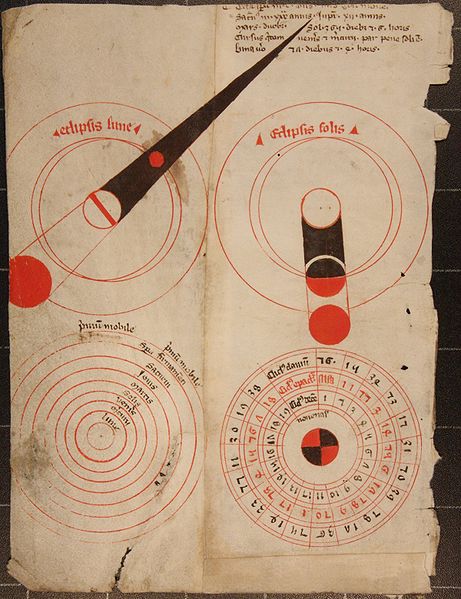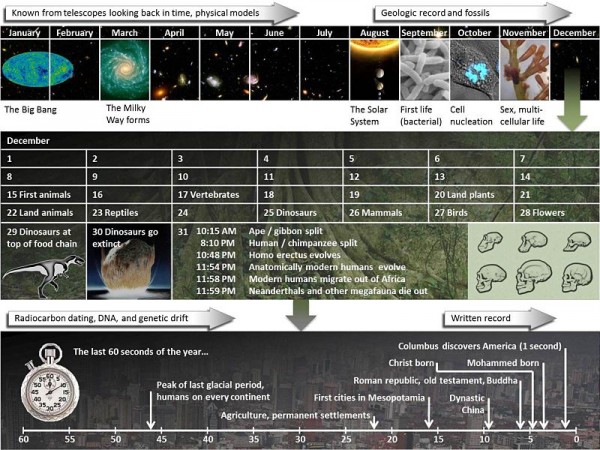The Cosmic Calendar
The Cosmic Calendar Quiz
Answer the 7 questions in this Quiz : First complete it individually, then discuss your responses with other group members – you can then change your response if you like!
Q1. What is the approximate age of the Universe?
A. 10 million years old
B. 15 million years old
C. 15 billion years old
D. Older than 20 billion years
E. None of the above
Q2. The first humans appeared on Earth approximately
A. 50 000 years ago
B. 200 000 years ago
C. 1 million years ago
D. 2 million years ago
E. None of the above
Q3. Where did the Universe come from?
A. it has always existed
B. it was created
C. a huge explosion of space, time, matter and energy
D. it was born from the debris left over after the destruction
of a previous universe
E. None of the above
Q4. How do we know how old the Sun is?
A. from Cosmic Microwave Background radiation discovered by
scientists in the 1960s
B. from archeological evidence
C. from calculations using classical physics
D. by using radioactive dating of objects such as meteorites
E. we have no way of knowing
Group Activity!
Imagine that the whole history of the Universe has been compressed into one calendar year with the Big Bang corresponding to the first second on New Year’s Day, and the present time to the last second on December 31st (midnight).
Jan 1 → Dec 31
Big Bang Today
Scientists estimate the age of the Universe to be 13.7 billion years old – but for this activity, take it to be 15 billion years old (because it makes the maths easier!). If we divide this number by 12 months, each month of our Cosmic Calendar will represent approximately 1.25 billion years.
Using this time scale – each month represents 1.25 billion years . . .
Brainstorm when some important events would have taken place between the Big Bang and Today
To download Events Cards and 12-month Calendar click on the link Events Cards and 12-month Calendar Dates of special note: — Humans arrived on the scene 7 min before Midnight on New Year’s Eve Dec 31! — Dinosaurs ruled from Dec 25 – Dec 30 for almost 200 million years
December Task 
Try to find out when the some of the following events occurred and then draw up your own calendar on poster paper for the month of December – make the box for December 31st extra large! (something like the calendar below)
Place these events on the appropriate days/hours/minutes/seconds of December – e.g. stone tools made their appearance on December 31st at 23:00 hours!
- The appearance of Proconsul and Ramapithecus – ancestors of apes and humans
- The first human beings appear
- Dinosaurs become extinct
- System of canals formed on Mars
- First trees appear
- The first worms
- Indian arithmetic and the invention of Zero and Decimals
- End of the last ice age
- The first flowers appear
- Use of Hubble telescope
- First primates appear
- Development of oxygen atmosphere on Earth
- The first amphibians appear
- Birth of Sir Isaac Newton
- The settling of Europeans into North America
- Discovery of agriculture
- First dinosaurs appear

- First cities of Neolithic Age
- Invention of computers
- The time of the astronomer Aristarchus
- Euclidean geometry
- Plankton first appears in oceans
- The Roman empire
- The Jurassic period
- Use of fire by Peking man
- First insects appear
- Paintings on cave walls in Europe
- The Bronze Age
- Extensive use of Stone tools
- Mayan civilization
To download the Worksheet for the December Task click on the link below
Questions to ponder and investigate . . .
- How old is the sun compared to other stars?
- What might we look like today if hominids on Earth had evolved a million years earlier?
- Has the Universe always been there?
- Why were calendars first used?
Why do we use calendars today?
What other calendars exist(ed)? How were they drawn up?
How have calendars changed over time? - Why would some people disagree with the time-scale of the Cosmic Calendar content?
- Why do we remember the past and not the future?
- Why is there a Universe?
Concluding thoughts:
The Cosmic Calendar was inspired by the late astronomer, Carl Sagan (1934-1996). Sagan was the first person to explain the history of the universe in one year – as a “Cosmic Calendar” – in his television series, Cosmos, and in his Pulitzer-prize winning book ‘The Dragons of Eden’. Conduct internet searches to find out more about his ‘Cosmic Calendar’ and look for excerpts from the TV series on U-Tube.
Did you know?
Within the scheme of the Cosmic Calendar, an average human life of 70-80 years is equivalent to approximately 0.16 cosmic seconds!
Help with the Maths!
To download the notes on How can I do the Maths click on the link below
Useful Links
– for more information and answers!
Teachers’ guide: Cosmic Calendar Teachers Notes
PowerPoint for Whiteboard: Cosmic-Calendar-Ppt-for-Whiteboard


